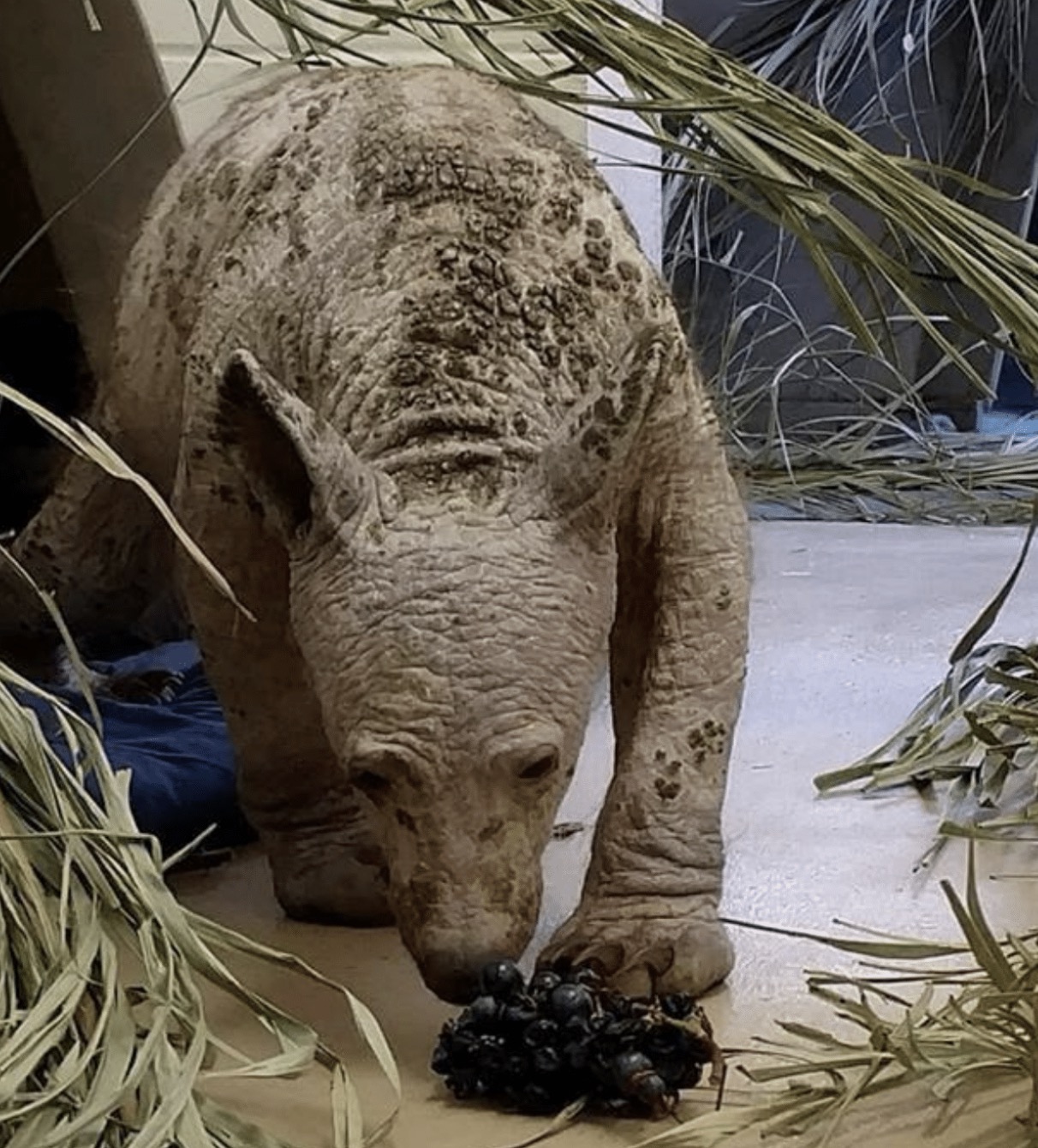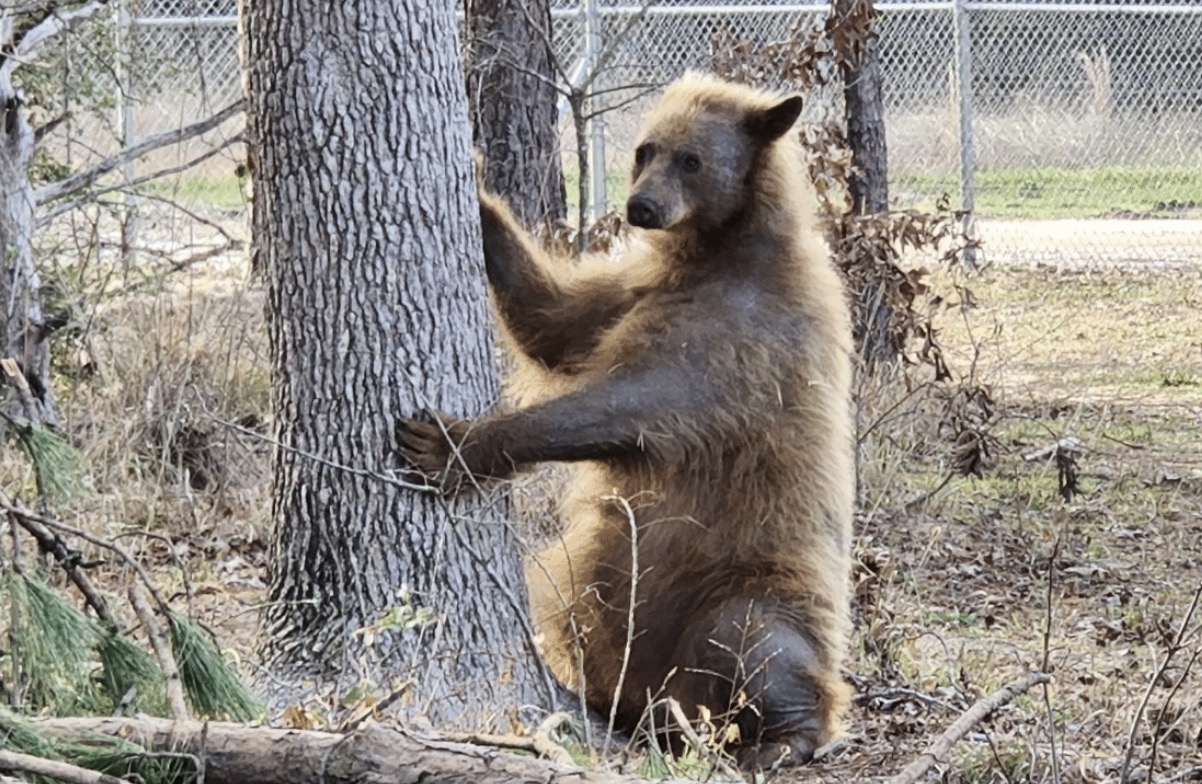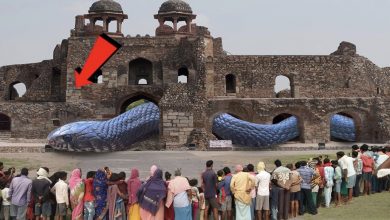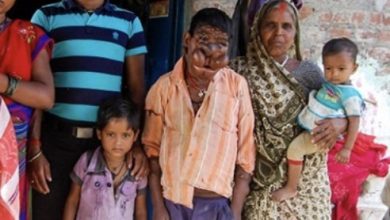Miracle in the Wild: How a Hairless Bear Cub Regrew Its Coat in Just 12 Months

When you imagine a bear, you probably think of a large, powerful creature, its massive body wrapped in thick fur that keeps it warm through cold winters. Bears rank among the largest meat‐eating animals on Earth, and their coats help them survive in harsh climates and blend into forests. But what if I told you there was a bear so bare and fragile that rescuers first wondered whether she was even a bear at all?
Meet Eve. When wildlife officials first saw her, she was a shocking sight: completely hairless, pink‐skinned, covered in scabs and sore spots, and small for her age. It was hard to believe that this fragile, mangy little animal was one of the proud black bears native to North America.
On Christmas Eve of 2017, officers from the California Department of Fish and Wildlife found Eve curled up inside an old dumpster in Placer County, suffering from extreme mange and severe malnutrition. That moment marked the start of an extraordinary journey—one that would test the limits of veterinary care, human compassion, and fundraising to give this young bear a second chance at life.
A Shocking Rescue at Christmas
It was a cold, gray morning when a local resident reported strange noises coming from behind some trash bins. The officers arrived to find a tiny bear cub with almost no fur, trembling with cold and clearly in pain. Mange—a skin disease caused by tiny mites—had ravaged her coat until only patches of crusty skin remained. Without hair, she had no insulation against the winter chill, and her body was too weak to hunt or climb.
The rescuers wrapped her in blankets and rushed her to a nearby wildlife hospital. There, doctors estimated she was only about eight months old, though bears of that age normally weigh twice as much. Her fur loss was so advanced that it was difficult to see the animal’s true shape under all the scabs and peeling skin. Everything about her looked raw and tender. She was pink like a newborn piglet, though her face and claws told the story of a wild creature used to roaming woodlands.
Veterinarians named her “Eve” because of the date: Christmas Eve. Even in the dim light of the exam room, it was clear she faced a tough road ahead. But the moment her big, dark eyes began to focus on the humans around her—and even tried to nuzzle a caring finger—everyone knew they had to do everything possible to help her heal.
Understanding Mange and Malnutrition
Mange in wildlife is no simple rash. It is caused by mange mites burrowing into the host’s skin, laying eggs, and triggering intense itching, hair loss, and open sores. In severe cases—known as sarcoptic mange—the animal scratches until its skin bleeds, leaving it open to infections. Eve’s body bore the marks of this battle: reddened patches, scabs, and raw spots where her skin was constantly irritated.

At the same time, staring at her rounded ribs and sunken flanks revealed she had also suffered from lack of food. A normal bear cub would be building up fat reserves to survive lean winter months, but Eve’s body had no energy left even for basic growth. Malnutrition can make mange worse, because a weakened immune system cannot fight off mites or heal skin wounds. The vets realized they would need to treat both her diet and her skin condition if Eve was to have any hope of recovery.
The Early Days of Treatment
Eve was moved to The Fund for Animals Wildlife Center, a rescue facility specializing in helping creatures that cannot survive on their own in the wild. From her first day, the staff gave her dedicated care: a warm stall away from drafts, soft bedding, and an easy‐to‐digest diet rich in proteins and fats. They weighed her every morning and recorded her food intake, making sure each meal included vitamins and supplements to rebuild her strength.
To tackle the mange, veterinarians applied medicated dips—gentle baths in chlorine‐type solutions to kill mange mites—and prescribed antibiotics and anti‐inflammatory medicines to prevent and treat skin infections. At first, she barely had enough energy to lift her head. Each bath was a struggle, her thin skin sensitive to even the mildest soaps. Yet day by day, she grew a little stronger.
By early January, her caretakers noticed Eve would sometimes lift her head to look around when staff entered her stall. She even began to step toward her food dish on her own, eager for another helping. While she had not yet sprouted any fur, her appetite and alertness were hopeful signs.
Months of Slow Progress
As the new year wore on, Eve’s transformation moved at a cautious pace. By April—four months after rescue—doctors could see tiny tufts of hair reappearing along her spine and behind her ears, though much of her body remained pink and bare. The wildlife center shared updates on their social media, writing that fur growth was “patchy but promising” and noting that the scabs had shrunk and the raw spots were healing.
But there were setbacks, too. Eve still battled itchy flare‐ups and occasional infections. Her new fur was fine and sparse, and her skin sometimes cracked in places. To keep her clean and comfortable, caretakers created a small “pool” area where she could splash around—helping to soften her scabs and soothe her itching. She seemed to enjoy this gentle play, nudging her keepers with wet muzzles and wagging her tail in delight.
Even so, the staff worried about her long‐term future. A wild bear without a full coat would struggle to stay warm in winter or hide from predators. With prongs of hair missing, she was vulnerable to sunburn in summer and frostbite in cold snaps. As June approached, the team knew they had to plan for a life indoors, rather than hope for a full return to the wild.
Nearing a Turning Point
By July—seven months after her rescue—the mange was nearly gone. The mites had been driven away, and the worst skin infections had healed under the gentle care of veterinarians. Now Eve needed to grow enough fur to protect her from the elements permanently. Patience was the watchword.
To keep her happy and engaged, the wildlife center built soft climbing platforms, scratching posts, and mystery boxes filled with treats. Eve began exploring her space more confidently. When caretakers arrived, she would peek over her stall’s door, sometimes letting out a soft grunt that sounded like a puppy’s whine. Volunteers called her “Eve the Brave” because despite months of baths, medicines, and vet visits, she never lost her curiosity or joie de vivre.
The center posted updates saying, “Eve’s coat is still thin, but it’s filling in in spots. We all want her to be strong and healthy, and our biggest wish is that she might one day return to her forest home.” Yet everyone knew that a bear with thin fur and a long rescue history would face serious challenges in the wilderness.
Deciding Eve’s Forever Home
In the fall of 2018, California faced devastating wildfires that burned millions of acres and forced countless animals to flee their habitats. With temperatures soaring and smoke choking the air, releasing Eve back into the wild was no longer an option. Even if her fur had fully returned, the risk of burns or smoke inhalation was too high.
After careful discussion, the Fund for Animals Wildlife Center announced that Eve would remain in human care for life. They reached out to supporters to raise money for her long‐term needs, explaining that each week of specialized care cost nearly five hundred dollars. Donations would fund a large indoor habitat, medical supplies, staff wages, and the special diet Eve required to maintain her health.
Soon, the center revealed plans to build Eve a permanent home at Cleveland Amory Black Beauty Ranch in Texas, a sanctuary run by a partner organization. There, she would live among other rescued animals, with a spacious, heated barn and an outdoor enclosure designed for bears with fur difficulties. The ranch’s climate and resources offered Eve the best chance of comfort and security for the rest of her life.
Community Rallies to Support Eve
News of Eve’s story spread far beyond California. Animal lovers across the United States sent donations, and local businesses held charity drives selling bracelets, T-shirts, and calendars featuring “Eve the Bare Bear.” Schools organized art contests where children drew pictures of Eve as she grew her new coat. Each hand‐drawn portrait and every dollar raised reminded the caretakers that Eve had touched many hearts.
On social media, people cheered every update: a fuzzy patch on her shoulder, a new tuft of hair behind her ear, the first time she rolled in fresh grass outside. Volunteers wrote, “Watching Eve’s transformation has been life-changing for us. She’s shown incredible strength and joy even when things looked hopeless.” The phrase “Bare but Brave” became a rallying cry—proof that even the most vulnerable creatures deserve our care and compassion.
A Spectacular Transformation
One year after her rescue—on Christmas Eve 2018—Eve looked almost unrecognizable. Her coat had grown in thick and glossy along her back, sides, and head. Small patches of thinner fur around her belly remained, reminders of her hard journey. She romped in her yard, climbed trees, and splashed herself with water from a kiddie pool on hot days.

Veterinarians ran final health checks and declared her skin completely free of mange mites. Her weight had nearly doubled, and she showed the playful spirit of any healthy bear cub. In a video posted online, Eve chased a ball with volunteers, snuffling and grunting with delight. Her once‐scarred skin now looked smooth under the sheen of fresh fur, and she carried herself with the proud confidence of a wild creature.
Staff at both the Wildlife Center and Black Beauty Ranch agreed: Eve’s recovery was nothing short of miraculous. What had begun as a heartbreaking sight—a bear stripped bare and left to fend for herself—had become a story of hope, grit, and the power of human kindness.
Eve’s Forever Home in Texas
Thanks to the outpouring of support, construction began on Eve’s permanent enclosure at Cleveland Amory Black Beauty Ranch. The facility featured a heated barn area for cold nights, an herb garden to give her fresh greens, a large pool for soaking and play, and a climbing structure built from safe, natural logs. Volunteers filled the yard with enrichment toys that encouraged her to dig, scratch, and chew—behaviors she would have used in the wild.
Every Friday, live cameras showed Eve in her yard, greeting visitors to the ranch’s website with a wave of her paw or a hearty belly rub. Children wrote letters telling her how brave she was. Wildlife experts praised the partnership between rescue centers, veterinarians, and donors who made Eve’s second chance possible.
A Lasting Lesson in Compassion
Eve’s story teaches us many things: that wildlife diseases like mange can devastate an animal’s life, that dedicated care can save even the most battered creatures, and that communities united by compassion can achieve remarkable results. She reminds us that every animal—no matter how small, sick, or helpless—deserves a chance to heal and live with dignity.
Her journey from a filthy dumpster to a spacious sanctuary in Texas also shows the power of perseverance. The veterinary team never gave up. Volunteers spent hours scrubbing her baths. Donors sacrificed their own money to keep her safe. And Eve herself never lost the spark that let her play in her little pool or reach out a paw for a gentle scratch behind the ears.
Today, Eve thrives in her forever home. She may never return to the wild, but she has a life filled with fresh food, veterinary care, and a place where she can climb, splash, and rest in peace. And her presence at the ranch continues to inspire new visitors every day, proving that a single act of rescue can ripple out to touch thousands of lives.










